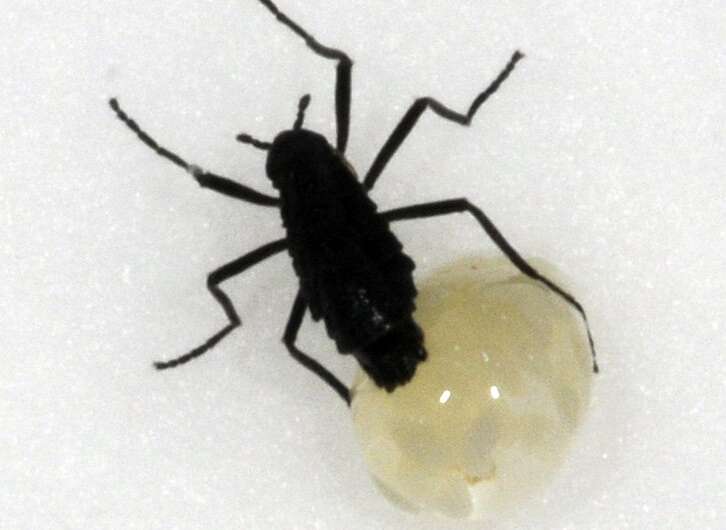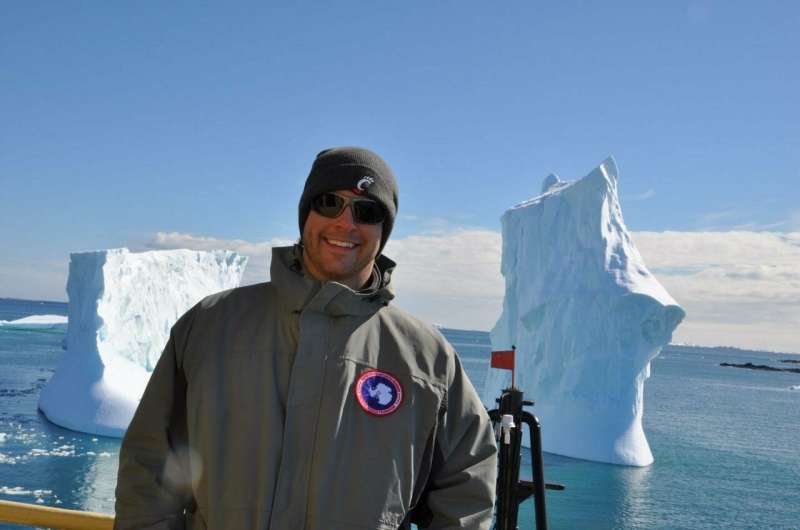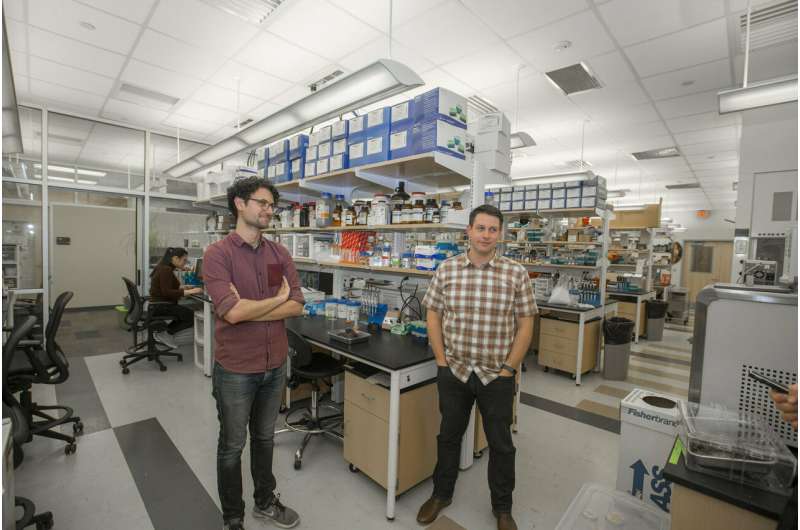Antarctic flies protect fragile eggs with 'antifreeze'

The good thing about the short Antarctic summer is it's a lot like a Midwest winter.
But for wingless flies, that's also the bad thing about Antarctic summers. The flies and their eggs must contend with an unpredictable pattern of alternating mild and bitterly cold days.
University of Cincinnati biologist Joshua Benoit traveled to this Land of the Midnight Sun to learn how Antarctica's only true insect can survive constant freezing and thawing. He found that the midges have surprising adaptations for life in their wintry realm.
Benoit and his students presented their findings in January at the Society for Integrative and Comparative Biology conference in Tampa, Florida.
Smaller than a Tic Tac, Belgica antarctica is the largest land animal found in Antarctica. Larvae resemble plum-colored worms. Adults are black and antlike.
At some point in their evolution, the little midges lost their wings—possibly to cope with the notorious Antarctic winds. Since they eat abundant algae and never travel far from where they're hatched, the flies don't need to fly.
Finding them isn't hard.
"You crawl around on the ground and dig in dirt, algae and moss until you find them," said Benoit, an assistant professor in UC's McMicken College of Arts and Sciences. "And because of the penguin colonies, there's a lot of penguin excrement, too."
Benoit has undertaken three scientific missions to Antarctica, conducting research out of Palmer Station in the U.S. Antarctic Program. Previously, he studied Antarctic ticks that feed on penguins and other sea birds.
For his latest project, Benoit examined the molecular mechanisms underlying the fly's reproduction. Like other midges, adult flies mate in big swarms during the brief Antarctic summer. The females lay eggs that hatch about 40 days later. Then the newborn flies spend the next two years developing as larvae, entombed for much of the year in ice.
It's only in their last week of life that they spread their wings, so to speak, as fully formed adults. They die just days after mating.
Scientists call them "extremophiles" for their ability to survive in extreme conditions.

"It could be living at a high elevation on a mountain—that's extreme. Or if you live in an extremely salty environment," he said.
Few creatures can survive the hostile conditions of Antarctica, Benoit said. The continent is home to a menagerie of tiny organisms such as mites and nematodes. It's the tiny fly's ability to withstand cold and dehydration that makes it an extremophile of Olympic proportions.
Scientists know that the midge larvae stay sheltered from the worst of Antarctica's blinding sun and bracing cold by remaining under a protective layer of moss and soil. Here the temperature and humidity are relatively constant.
But during the Antarctic summer, daily temperatures can soar into the 40s and dip well below freezing. UC researchers wanted to know how the midge's eggs tolerate such big temperature swings.
"The females secrete this clear jelly around the eggs. Essentially, it's like antifreeze," UC student and study lead author Geoffrey Finch said. "It acts as a temperature buffer against those fluctuations to help them survive."
The gel also helps the eggs survive Antarctica's other defining climate feature—its dryness. Antarctica is home to the world's biggest desert. Belgica can survive even after losing more than 70 percent of its water content. By comparison, studies have found that people begin to suffer cognitive impairments when we lose as little as 2 percent of our water content through dehydration.
"So having all these unique adaptations is what allows them to live in this extreme environment," Benoit said.
UC's researchers found that the flies begin synthesizing components found in the temperature-resistant gel they they will use to protect their eggs many months in advance as mere larvae.
"That was kind of interesting," Finch said. "The gel has a lot of unique components. We found some of them were already being manufactured in the larval stage."
Finch said he admires the little flies not just because they survive in Antarctica but because they can only survive in a place like Antarctica. The midges die when exposed too long to the room temperature we find ideal.
"I don't find anything repulsive about them. They're fascinating for their ability to survive those harsh conditions," Finch said.

Now that UC researchers have a better understanding of the molecular processes behind the fly's reproduction, they want to learn how climate change might affect species adapted to living in one of the coldest places on Earth. Benoit said Antarctica's isolation and extreme polar location make it an ideal place to study this phenomena.
"It's at the poles where you really see the big effects of climate change," Benoit said. "You see these glaciers disappear. You see less snowfall. Snow cover doesn't last as long from year to year."
Reaching the isolated American research station requires flying to the southern tip of Chile and embarking on a five-day voyage over some of the world's most treacherous seas. The coastal outpost consists of a handful of buildings on a rocky shore.
Palmer Station is the seasonal home to about 50 staff and researchers who live in dorms. The station has its own chef so scientists can devote more time to their fieldwork.
"Fresh fruits and vegetables are not always available, but the chef is really good. There is always a lot of variety. It's not like Shackleton," Benoit said, invoking the early 20th-century polar explorer Ernest Shackleton. "They were eating penguins."
The kitchen always has fresh-baked cookies on hand.
"You had to watch that or you'd gain a lot of weight," he said.
Researchers settle into a daily routine of working long hours in the field or running experiments at the station while soaking in the stark beauty of the southern continent. For his work, Benoit often took a rigid inflatable boat to small islands each morning to collect flies. Along the way, he would see penguins—Adelie, chinstrap and gentoo— scattered among the rocks and leopard seals and killer whales that haunted the shoreline. The sky was filled with petrels, skuas and the occasional albatross.
"It's fun. You get this six-week chunk of time to focus on research," Benoit said.
But academic obligations follow professors even to the edge of the Earth. Benoit said he spent nights answering emails and attending to his university duties back in Cincinnati.
It's not all work. The station has a little gym and a pub with a pool table. Scientists cleaned the research center together each week. At night they listened to guest speakers or watched movies together from the center's vast digital library. Visiting researchers could even request a new release to be downloaded.
Occasionally, they would get visitors. One day, Microsoft billionaire Paul Allen visited the station with actor and comedian Dan Aykroyd.
"You don't expect to go to Antarctica and meet Dan Aykroyd," Benoit said. "But he was really interested in science."
Benoit is applying for more research grants to return to Antarctica.
"The hardest thing is being away from your family for so long," Benoit said. "You can quickly burn yourself out by working too much. You see researchers walking around like a zombie trying to cram 20 weeks of work into eight weeks. I shouldn't say anything because I do the same thing. It's such a rare opportunity. It's a great experience."
Provided by University of Cincinnati



















